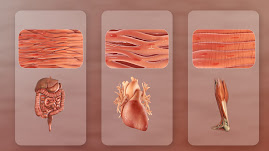HUMAN MUSCLES
-There are about 600 muscles in a human body.
• Classification of muscles based on different factors :
(1) Depending upon striation.
(2) Depending upon the control.
(3) Depending upon the situation.
1) Depending upon striation :
– Depending upon presence or absence of striation muscles are classified as,
(a) Striation muscle
(b) non- striated muscle.
*Striated muscle :
( skeletal muscle and cardiac muscle )
– Has large number of cross Striation.
* Unstriated muscle :
(Smooth muscle)
– Does not have cross Striations.
2) Depending upon control :
– Two types ,
(a) Voluntary muscle
(b) Involuntary muscle.
* Voluntary muscle :
( Skeletal muscle )
– Muscles that can be controlled by the will are called voluntary muscle.
– Nerve supply :Somatic nerves
* Involuntary muscle :
(Cardiac muscle and smooth muscle )
– These muscles are cannot be controlled by will.
– Nerve supply :Autonomic nerves
3) Depending upon situation :
– Three types ,
(a) Skeletal muscle
(b) Cardiac muscle
(c) Smooth muscle.
* Skeletal muscle :
– Muscle that are associated with bones forming the Skeletal system are called skeletal muscle.
– These muscles are cylindrical and unbranched.
– These are voluntary and striated .
– Fibers are arranged parallelly .
– Length : 1 to 4 cm.
– Diameter : 10 to 100 micro
– Myofibrils, Sarcomere , Troponin are present in skeletal muscle.
– Sarcotubular system is well developed.
– T-tubules are long and thin.
– Depolarization occurs upon stimulation.
-Resting membrane potential is stable.
– In skeletal muscle , sarcoplasmic reticulum is the source of calcium and for the contraction , calcium ions binds with Troponin.
– Speed of contraction of skeletal muscle is very quick.
– Neuromuscular junction is well defined.
– Control of action is neurogenic.
*Cardiac muscle :
– These muscle form musculature of the heart .
– These are voluntary and striated.
– These muscles are branched.
– Length – 80 to 100 micro.
– Diameter – 15 to 20 micro.
– Myofibrils , sarcomere, Troponin are present.
– Sarcotubular system is well developed.
– T – tubules are short and broad.
– spontaneous depolarisation occurs.
– Resting membrane potential is stable.
– Sarcoplasmic reticulum is the source of calcium and for trigger of contraction calcium binds with Troponin.
– Intermediate contraction can be seen.
– Neuromuscular junction is ill defined .
-Control of action is myogenic.
– Supplied by autonomic nerve fibers.
* Smooth muscle :
– These muscles are present in association with viscera and also called as visceral muscle.
– Involuntary and Non striated muscle.
-They are spinal shaped and unbranched.
– Length : 50 to 200 micro.
– Diameter : 2 to 5 micro.
– Myofibrils, Sarcomere, Troponin are absent.
– Sarcotubular system is poorly developed.
– T- tubules are absent.
– Depolarization is Spontaneous.
– Resting membrane potential is unstable.
– Extracellular fluid is the source of calcium and for trigger of contraction calcium binds with calmodulin.
– Speed of contraction is slow.
– Neuromuscular junction is ill defined.
– Control of action is neurogenic and myogenic.
– Supplied by Autonomic nerve fibers.
THANK YOU.
…..BY PHYSIOFEEDS
FOLLOW ME IN SOCIAL MEDIA





Pingback: STRUCTURE OF SKELETAL MUSCLE - PHYSIOFEEDS